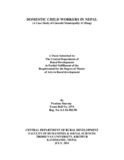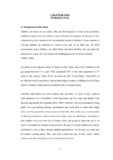Please use this identifier to cite or link to this item:
https://elibrary.tucl.edu.np/handle/123456789/3481| Title: | Domestic Child Workers in Nepal (A Case Study of Ghorahi Municipality-11 Dang) |
| Authors: | Sharma, Pratima |
| Keywords: | Child workers;Socio economic |
| Issue Date: | 2011 |
| Publisher: | Central Departmental of Rural Development |
| Institute Name: | Central Department of Rural Development |
| Level: | Masters |
| Abstract: | Children are future of the nation. They are the beginner of every new generation. Childhood stage is the most effective stage of human development. So the type of life, a human being lives depend on the development period of children. A large number of working children are deprived in various ways and are in high risk. So these economically active children, are child labors and those children who are deprived, harassed and at risk, are very serious and challenging issues of Nepal currently (CWIN,1998). According to the national census of Nepal of 2001, there were 43.6% children in the age group between 5-17 years. This comprised 33% of the total population (5-17 years) of the country, where 18.5% are male and 28.5 % are female. About 84% of the children lived in rural areas, among them higher number of children lived in Terai region, secondly in hilly region and thirdly in the mountain. The demand for domestic child workers is comparatively high than the adults because they are easier, cheap, unaware and unable to demand their human and legal rights. Domestic child workers mostly come from poor, often large rural families. DCLs are poorly paid; sometimes they are not paid at all. They are deprived of schooling, playing and social activity and emotional support from the family and friends. The study “Domestic Child Workers in Nepal: A case study of Ghorahi Municipality -11, Dang” has been conducted at ward no. 11 of Dang with a general objective to find out the socio- economic condition of domestic child labor in the study area and other objectives of the study were to identify the contributing factors leading to DCLs to access the major problems faced by the domestic child labor and to suggest for policy implications of the welfare of DCLs in the study area. To collect the data different tools like questionnaire, observation has been used. Descriptive and exploratory research design has been followed to describe and examine the findings of the study. The census of the DCLs of the study area had not been enumerated by any governmental or non-governmental organization, so the actual number of child labors of the area had not been found. From the universe, total 50 numbers of child labors were purposively selected with accidental sampling method on the basis of gender, caste and ethnicity. The study concludes that children of the poor families are in vulnerable conditions. Poverty and deprivation are the root cause of child labor, simply, the ignorance of the guardians, family breakdown and the general trend of child exploitation in the societies are the other contributing factors leading to the child labor. Inequitable distribution of land, lack of people centered sustainable development, poor access of resources and environmental degradation are also responsible for the child labor problem of Nepal. When a child is exploited for the economic gain of others, the child loses and the world loses. A nation can not achieve prosperity on the backs of its children so that a progressive intervention should be done for the prevention and control of child labor exploitation. Meaningful education can be taken as an effective intervention to check the child labor. All the development actors should play effective role to control the child labor. Moreover, child laborers, parents, students, teachers, trade unionists, employers, social workers and people from all walks of life should be influenced and mobilized for the prevention and protection of working children in society. |
| URI: | http://elibrary.tucl.edu.np/handle/123456789/3481 |
| Appears in Collections: | Rural Development |
Files in This Item:
| File | Description | Size | Format | |
|---|---|---|---|---|
| Cover.pdf | 29.61 kB | Adobe PDF |  View/Open | |
| Chapter.pdf | 212.49 kB | Adobe PDF |  View/Open |
Items in DSpace are protected by copyright, with all rights reserved, unless otherwise indicated.
